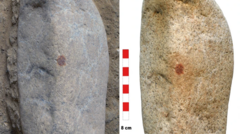Scientists in Spain have unveiled a remarkable discovery that challenges our understanding of Neanderthals and their cognitive abilities. Excavations at the San Lázaro rock shelter in Segovia have led to the unearthing of the oldest known full human fingerprint, believed to have belonged to a Neanderthal. The rock, resembling a human face, features a red pigment dot possibly made by the Neanderthal’s finger, suggesting their capacity for artistic expression around 43,000 years ago.
María de Andrés-Herrero, a co-author of the study from the University of Complutense in Madrid, explained that this finding has significant implications for the ongoing debate regarding Neanderthals' ability to create art. The strategic placement of the red dot on the pebble indicates a level of abstract thought typically associated with modern humans. De Andrés-Herrero emphasized that this pebble represents the first known instance of a pigment-marked object in an archaeological context, further solidifying it as a crucial piece of portable art.
The excavation project has been ongoing for five years, with the significant find occurring below 1.5 meters (5 feet) of sediment associated with Neanderthal habitation. Collaborating with Spain’s scientific police, researchers conducted multi-spectrum analyses confirming the presence of ochre pigment, a natural clay ingredient historically used by early humans.
Archaeologist David Álvarez Alonso highlighted the challenges in making definitive comparisons due to the lack of other Neanderthal fingerprint references. However, they are confident that the pebble symbolizes intentional artistic behavior rather than accidental markings. The pigment source, absent in the surrounding shelter, further supports the theory that the Neanderthal intentionally brought the pigment to the area.
In their published research, the scientists argue that the characteristics of the pebble render it "exceptional," advocating for its classification as a visual symbol and a piece of portable art. The implications of these findings could lead to a re-evaluation of the cognitive and cultural capabilities attributed to Neanderthals, suggesting they had a deeper understanding of artistic expression than previously recognized.
This discovery not only adds to our knowledge of Neanderthal behavior but also sparks new conversations about the origins and evolution of human creativity. As researchers continue to study these ancient artifacts, the notion of what it means to be "human" is being redefined, lending insight into our own evolutionary past.




















